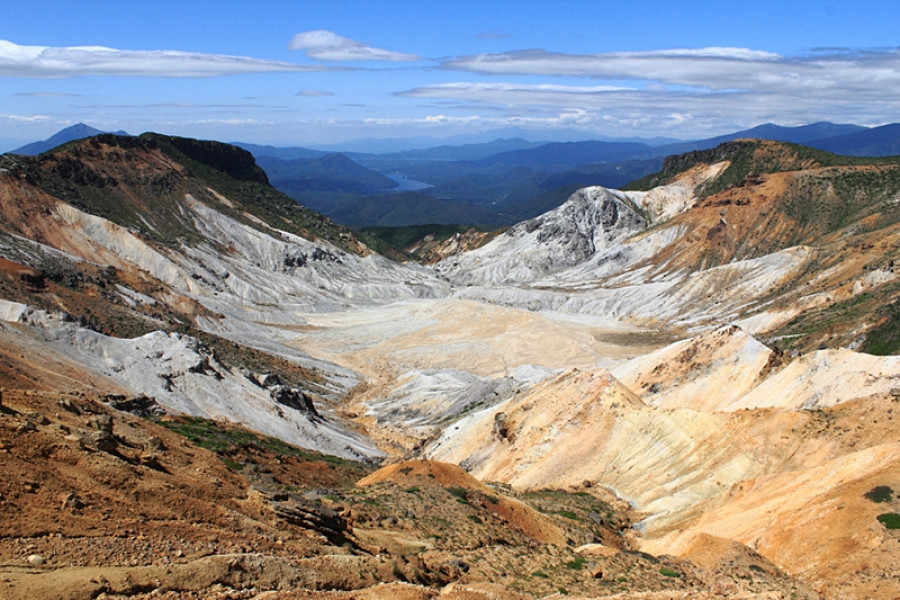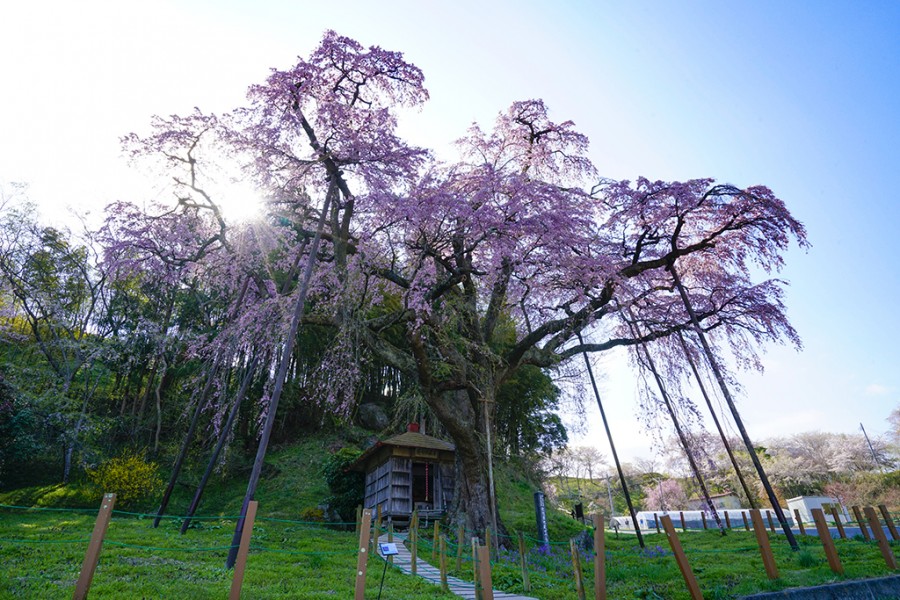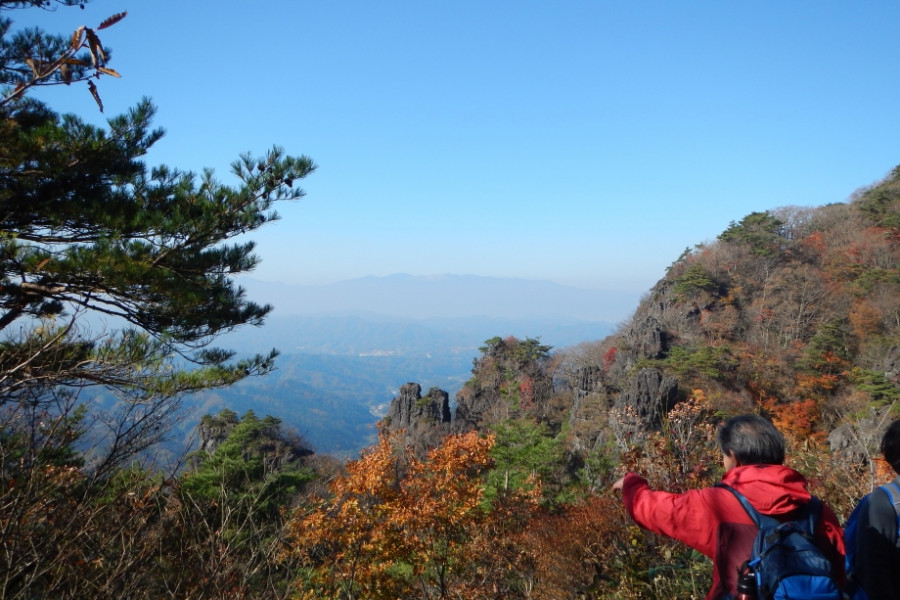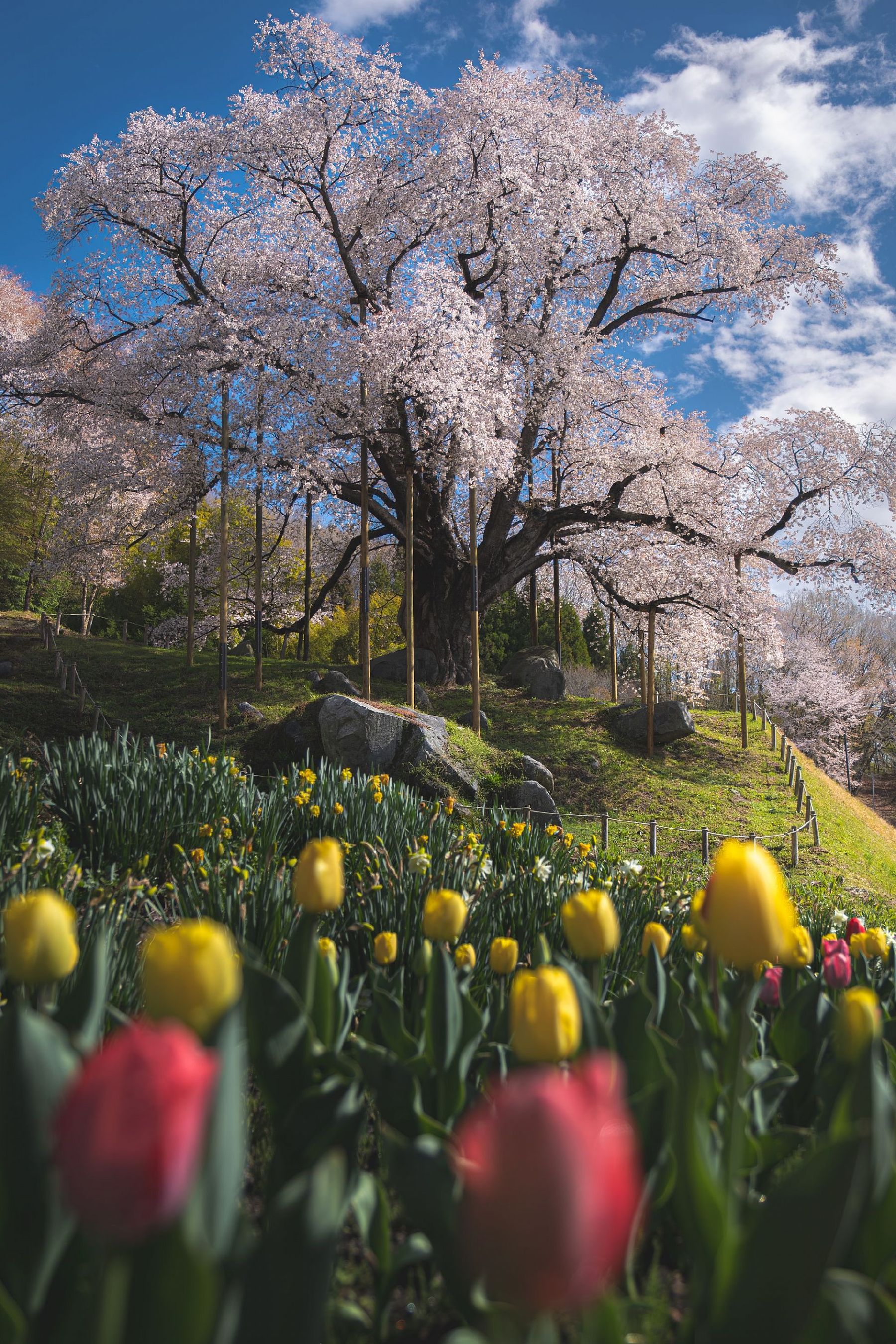
Noji Onsen
Noji Onsen is a beautifully scenic onsen resort in Adatara mountains. It is especially breathtaking when the outdoor baths, and their cloudy white waters, are surrounded by stunning snowy landscapes in winter.

Mt. Adatara is actually made up of multiple active volcanoes that form a broad mountain. It last erupted in 1996. Poems in the book Chieko-sho by Kotaro Takamura (1883-1956) helped make the mountain famous.

The summit of Mt. Adatara stands at an altitude of 1700 m, stretching about 9 kilometers in a north-to-south direction. Views of Mt. Adatara are lovely in and of themselves, but the views that visitors have of the surrounding area once they reach the summit are breathtaking. Chosen as one of Japan’s top 100 mountains, as well as one of the top 100 mountains for flowers, a view spot at an altitude of 1300 m can be accessed by gondola lift. This means that it is relatively easy to climb even for beginners.

On summer evenings, a light-up event inspired by the Milky Way and the flowers of Mt. Adatara is held, gracing those scaling the mountain by a gondola lift with a spectacular view. In autumn, visitors are afforded a stunning view of autumn leaves making it a popular place for scenic momiji-gari (autumn leaf viewing).
Kurogane-goya Mountain Lodge (temporarily closed as of August 2023) is a rest stop for visitors (it serves as lodging for those on long hikes). Stay here overnight to sample the lodge's famous curry, which is reserved for overnight guests only. The lodge’s public hot spring facility uses naturally-sourced, cloudy hot spring water.
| Website | http://www.nihonmatsu-kanko.jp/?p=462(Automated translation available) |
|---|---|
| Contact | Nihonmatsu Tourism Federation (+81) 243-55-5122 |
| Best Season | All Year |
| Parking | Available |
| Access | Okudake Onsen, Nihonmatsu City, Fukushima Pref. 964-0075 View directions |
|---|---|
| Getting there | The most popular trailhead for hiking Mt. Adatara is the Okudake Trailhead, starting at Adatara Kogen Ski Resort. By Car: 20 min drive from Nihonmatsu I.C. exit off the Tohoku Expressway Mountain and Travel Course Guide Useful Links |

Noji Onsen is a beautifully scenic onsen resort in Adatara mountains. It is especially breathtaking when the outdoor baths, and their cloudy white waters, are surrounded by stunning snowy landscapes in winter.

The Kura Café Sen no Hana is located on the grounds on Kunitaya Miso Factory in a remodeled kura (storehouse). Try the local flavors of Fukushima cuisine with their lovely lunch items featuring locally Nihonmatsu-produced miso and soy sauce. There are also many other menu items to appreciate, such as amazake, Mongolian-style tea, and coffee. The inside of the shop is also calming and decorated with local pressed flowers.Open from 11:00 a.m. to 6:00 p.m. (with a break from 2:00 to 3:00 p.m.), the Kura Café Sen no Hana is sure to give your taste buds a treat. Their fair prices and delicious cuisine make them popular with locals and visitors alike.The amazake, a nonalcoholic drink made from koji, or fermentation starter, is popular with guests. As for food, the zaku zaku soup is a traditional soup of chunky cubed vegetables which is eaten on special occasions like festivals and ceremonies, it is a famous Nihonmatsu specialty. But if you’re wanting to go for dinner, make sure you’re there before the last order at 5:30 p.m. (4:30 p.m. on Sundays). Next door to the Kura Cafe Sen no Hana, guests can also visit the Kunitaya Miso Factory. The redwood lattice of the exterior is especially attractive. In addition to the tours, the Factory also sells miso, soy sauce, and koji, which is used to make Fukushima’s famous 'sagohachi' pickles.All the products for sale are made at the Kunitaya Miso Factory and use pure water from Mt. Adatara and locally grown ingredients. It’s a great way to get the fresh flavors of Fukushima Prefecture. There are also seasonal products available, so be sure to have a look!

Fukushima Prefectural Museum of Art, located at the foot of Mt. Shinobu on the north side of Fukushima City, houses over 2,000 pieces of art, including paintings, block prints, carvings, craft works, and more. Some highlights of the museum's collection include paintings by Shoji Sekine and woodblock prints by Kiyoshi Saito, both of whom were born in Fukushima Prefecture, as well as a collection of impressionist art, and 20th century paintings by artists such as Ben Shahn and Andrew Whyeth.

This weeping cherry tree is around 400 years old and is called the "daughter" of Miharu Takizakura, another famous cherry tree located in Fukushima. Countless visitors have visited from inside and outside the prefecture after hearing about the beauty of this cherry tree. Photography tip: Around 2 pm is the best time to take a picture.

The Ja no Hana Gardens (蛇の鼻) are located in Motomiya, in the central area of Fukushima. From spring to autumn, this vast park features a display of natural wonders like cherry blossoms, wisteria, roses, hydrangeas, water lilies, and autumn leaves. It is particularly famous for its 500-year-old wisteria tree that typically blooms in May.There is also a historical residence, Ja no Hana-goten (Ja no Hana mansion), which is a registered tangible cultural property of Japan. Built in 1904, the impressive residence has intricate wooden carvings in the front entrance, and houses artworks and calligraphy works, often housing exhibitions. Visitors can enter the house and look at the artwork up close.Best season: Cherry blossoms: Early to late April Tulips: April to early May Peonies: Early to mid May Japanese wisteria: Early to late May Azaleas: Early to mid May Roses: Most varieties reach their peak around late May; from then until November, other varying kinds might be in bloom Water lilies: June to July Autumn leaves: Late October to November

Mt. Ryozen is a spiritual, historic mountain with beautiful scenery. Since the Muromachi Period, Ryozen Temple has been used as a training grounds for Buddhist monks. Apparently, monks-in-training used to tie themselves to cliff-edges as part of their training in self-discipline!Hikers can park at the Mt. Ryozen Trailhead Parking Lot.

Hanamiyama Park is a privately-owned field for flowering and ornamental trees, in southeast Fukushima City.The park is located within a satoyama-type landscape i.e. managed woodland hill country close to human habitat. What originally began more than 60 years ago with local farmers planting flowers and trees, has grown into a beautiful scene. The landowner generously turned the area into a park in 1959 to allow visitors to enjoy the beautiful flowers there.Hanamiyama Park, and the wider Hanamiyama area, is now visited by thousands of admirers every year!Springtime visits see cherry, plum, and forsythia trees paint everything in vivid colors. A gentle pink and purple landscape waving in the breeze with the picturesque snow-capped Azuma Mountains in the distance makes for an amazing sight.The riot of spring colors is spectacular enough to merit calling this park Fukushima's very own paradise.The flowering landscape moves all who see it and has been preserved through the cooperation of the local residents. Enjoy a leisurely one-hour stroll that will take you from the foot of the hill to the summit. Travel through groves of flowering trees and other vibrant flowers in full bloom.Hanamiyama is the perfect getaway for a day for nature lovers, hikers, or people trying to escape for a short time.The best part is that spring isn’t the only beautiful time to visit. Marvel in wonder during the lush green summer foliage or the dappled colors of autumn. When you visit this fairytale-like wonderland, it is recommended that visitors wear comfortable walking shoes as the terrain includes graveled paths, steep slopes, and slippery areas. Mid- through late April is the peak season, so ready your camera and your heart for the beauty that awaits.

This huge Japanese cherry tree is over 400 years old and has been designated as a national Natural Treasure. The tree has a trunk circumference of about 7.2 meters and stands 20 meters high, and was thus selected as one of the "100 Giants of the Forest" by Japan's Forestry Agency. Koshidai Cherry Blossom Festival is held every year on May 3. A Yabusame horseback archery event accompanied by taiko drumming takes place during this festival, and local organizations set up food stalls.Photo tip: Try taking photos from the south side of cherry blossoms.